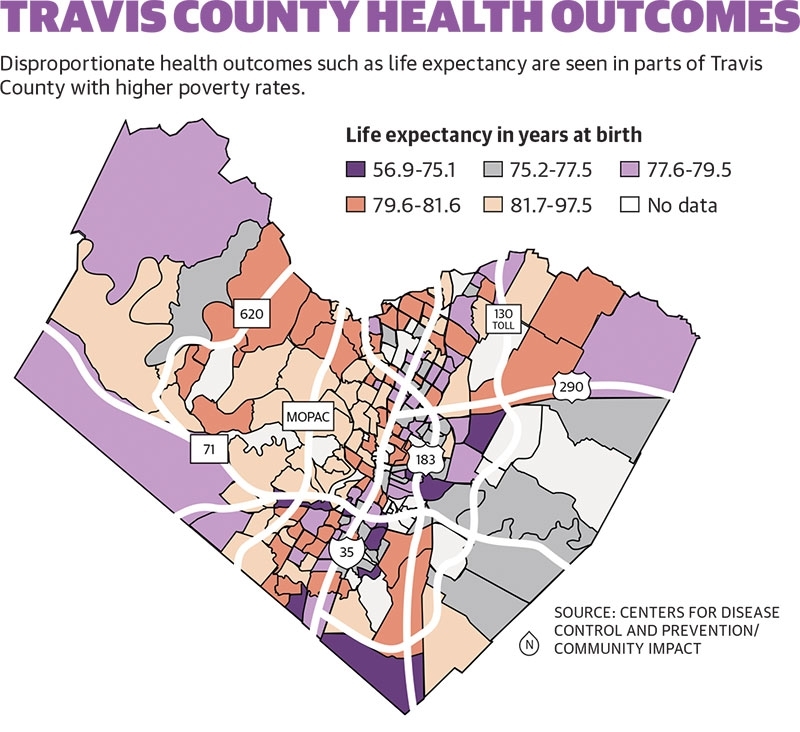Travis County’s hospital district for low-income residents, Central Health, is facing a lawsuit, an audit and a leadership change as residents continue to express concern about lack of services, especially in the eastern part of the county where health outcomes are traditionally worse.
Central Health debate
A legal battle between the hospital district and its private partner Ascension Seton began in January. Central Health filed a lawsuit claiming that the hospital failed to provide care to enough low-income residents, echoing concerns some residents and activists expressed over the last several years.
Central Health and Ascension Seton established an agreement back in 2013 to provide care for the county’s low-income and uninsured population through the Medical Access Program.
Central Health cited a 21% reduction in services from 2013 to 2022.
In response, Ascension Seton said Central Health had “misrepresented” its agreement and “distorted” numbers related to the Medicare program amid rising demand.
“For more than five years, and as the Travis County population continues to grow, demand for MAP services has far exceeded the number of individuals the program was designed and funded to support,” Ascension Seton representatives said in a January statement.
Ascension Seton fired back with a lawsuit against Central Health in the same month claiming the health care district both over-enrolled and underfunded the MAP program.
Meanwhile, a May report from Central Health stated the district increased the number of patients it served by 4% in 2022 compared to 2021, serving 1 out of every 9 Travis County residents.
Also in May, Ascension Seton initiated a “governance and funding deadlock,” a move that could lead to further negotiations between the parties or terminate the partnership. Travis County Commissioner Jeff Travillion said the situation showed a "disconnect" between Central Health and the hospital.
County commissioners and some local groups have also criticized Central Health for its financial management and provision of care, leading to a performance audit that kicked off in May and is set to be completed in January 2024. That $845,200 review comes in addition to Central Health's annual performance audits, which have come back clean since the district's creation.
The health care district will also undergo a leadership change in 2023 as Mike Geeslin, its president and CEO of six years, announced in April he will step down by the end of the year.
The district’s board of managers formed an ad hoc committee that in May began the search process for Geeslin’s successor. The group plans on hiring his replacement by this fall.
East side focus
As Central Health contends with those issues, east side residents continue to face lacking health care options and outcomes compared with central and western areas of the county. New initiatives underway could expand offerings in those communities in the near future.
According to Central Health data, adults in many communities east of I-35 and US 183 have higher rates of conditions like asthma, heart and obstructive pulmonary disease, and poor mental and physical health than the county average.

Despite such varying outcomes in health and socioeconomic factors, getting connected with health care service on the east side can be more challenging than around Austin’s central neighborhoods or to the west.
CommUnity Care, a nonprofit partner of Central Health, operates one mobile clinic and one physical health center between US 183 and Hwy. 130, and two more health centers are located east of SH 130.
Some other urgent care and health care centers are situated closer to Manor. But there are few other treatment options around the broader east side area, with no larger hospital facilities closer than Central Austin.
“The Eastern Crescent of Austin has historically been underserved, especially concerning preventative services. Centers for health care and preventive services have often been located to the west of I-35, limiting access for East Austin residents,” said City Council Member Natasha Harper-Madison, who represents Northeast Austin's District 1.
Harper-Madison said the city and Austin Public Health are working to address disparities by
- Responding to the Community Health Assessment
- Providing fresh produce in areas with food access barriers or higher disease rates through the Fresh for Less initiative
- Bringing vaccines to communities through the Mobile Vaccination Program
- Holding Diabetes Education and Prevention Classes in East Austin
In an attempt to address those needs, Central Health is also developing a new equity-centered strategic plan as it works to improve the region’s “safety-net” health care system. Community engagement is ongoing, and Central Health representatives said during a June 1 presentation to county commissioners that the initiative is roughly halfway through with final financial and operational planning to come soon.
“In just a few short years, we’ve moved from temporary clinics in eastern Travis County to constructing permanent health and wellness centers in Del Valle, Hornsby Bend and a multispecialty clinic in East Austin. Our new Healthcare Equity Plan is providing a roadmap for the future of safety net healthcare in our community and will guide how we can make life better for the people that we serve for decades to come,” Geeslin said in a May statement.
A large-scale, city-backed development initiative coming in Northeast Austin is also intended to expand access to housing, health care and other features the area has historically lacked.
The Colony Park Sustainable Community project will transform 208 acres of city land into a new mixed-use development. Catellus Development Corp. is managing the community’s build-out, which could resemble the company’s work with the Mueller redevelopment in Central Austin.
The program will also feature Central Health as part of the core development. Austin sold 2.28 acres at Colony Park to the hospital district early last year, and a health and wellness center will be brought to the site as a key piece of the master-planned neighborhood.
”Foundational to the development of the Colony Park Sustainable Community is to provide access to amenities and resources that have been absent from the existing community,” Harper-Madison said. “With the development of the Colony Park Health and Wellness Center, the Colony Park Sustainable Community and the City will accomplish the first phase of delivering community benefits from the very beginning of the development.”






